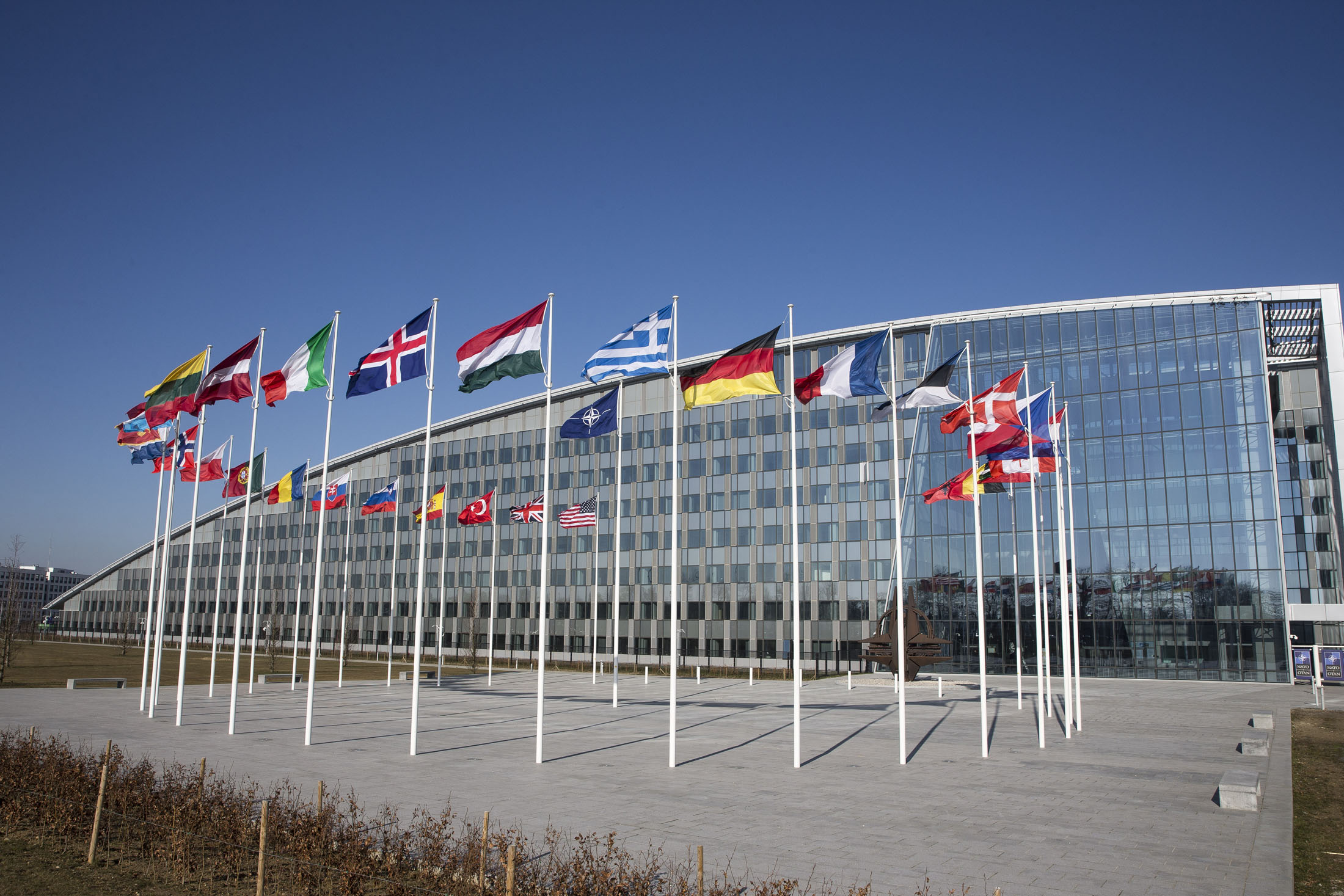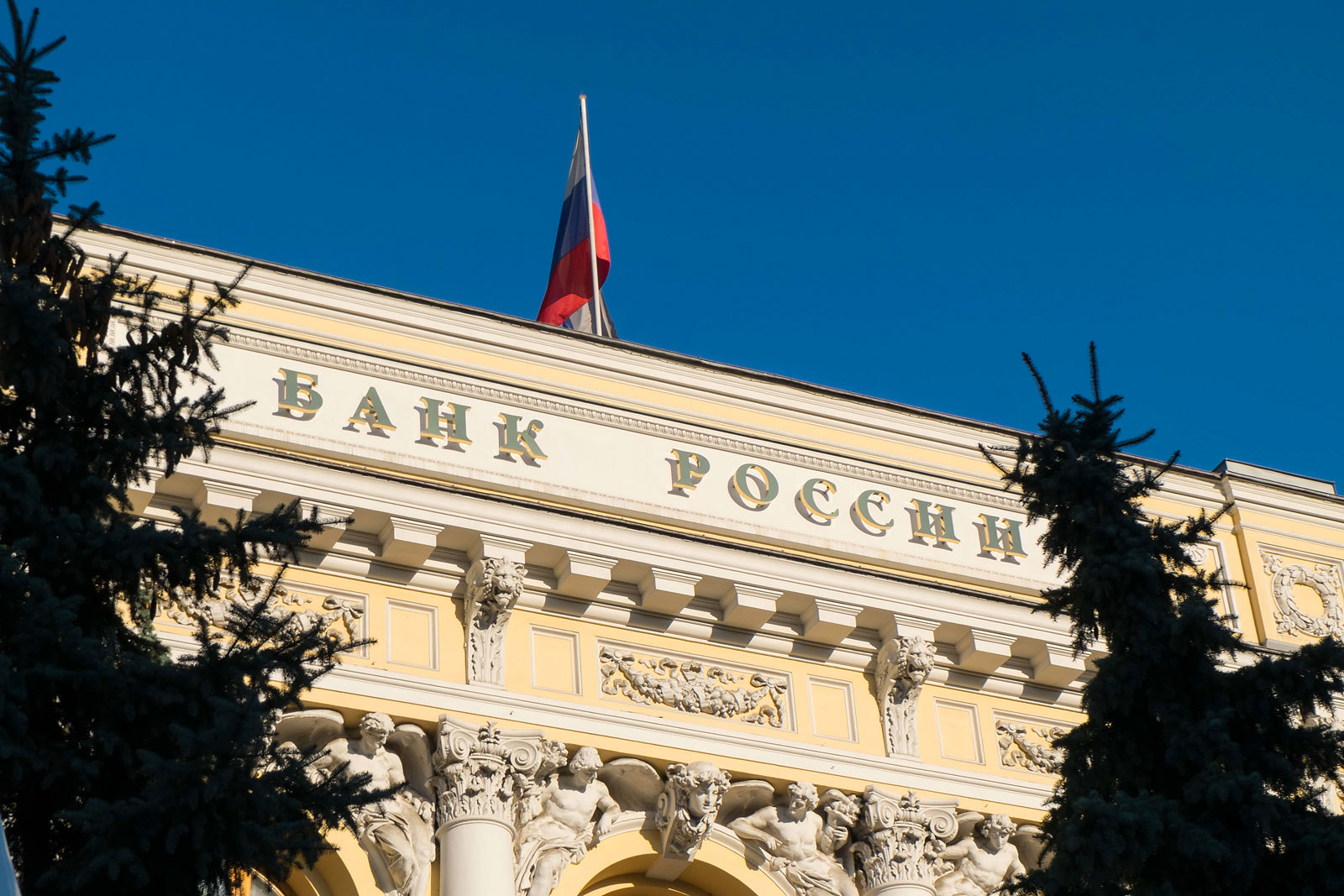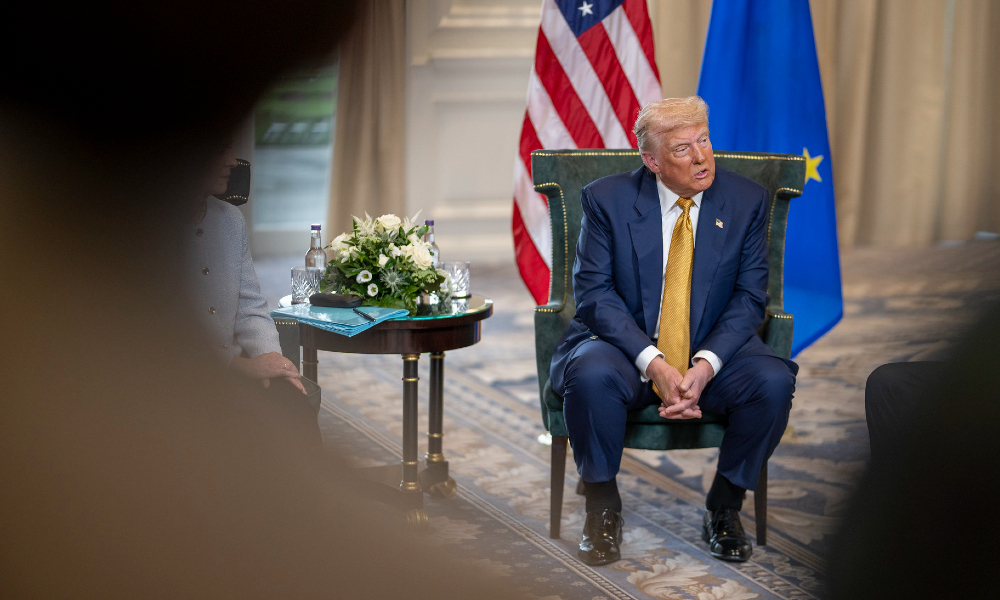Human Security and Changing Threats: NATO’s Policies for 2022 and Beyond
NATO’s 2022 Strategic Concept and its guiding principles document on human security reflect the alliance’s new focus on strategic competition, the threat from Russia’s war in Europe, and a more holistic approach to security.

Published by The Lawfare Institute
in Cooperation With

Although Polish President Andrzej Duda confirmed that the missile that killed two Polish citizens inside the country’s borders in November was an accidental result of a Ukrainian counteroffense rather than a Russian attack, the episode sent experts rushing to the founding documents of the North Atlantic Treaty Organization (NATO) to determine whether an unintentional strike could trigger the obligation of collective defense set out in Article 5 of the North Atlantic Treaty. The episode served as an alarming reminder of the importance of examining NATO’s current posture and policies toward collective defense.
NATO has released two policies that help define its collective defense strategy in the past few months. These are the NATO 2022 Strategic Concept and the document entitled “Human Security: Approach and Guiding Principles” (or “Guiding Principles”). NATO’s Strategic Concepts are public documents adopted by consensus that highlight the current purpose, principles, and tasks of the alliance. The 2022 Strategic Concept is the eighth release since the first concept was produced in 1949. The Guiding Principles on human security, a new kind of guidance released for the first time in 2022, pairs closely with the Strategic Concept in order to provide a more comprehensive view of the human environment and understanding of conflict and crisis. The following synopsis reviews the newest Strategic Concept in contrast to NATO’s previous strategic concept from 2010 in concert with the new Guiding Principles.
Reaffirming Old Principles
Many of the alliance’s values and operations as reflected in the 2022 Strategic Concept have, unsurprisingly, remained constant since 2010. For example, both Strategic Concepts convey the allies’ shared commitment to the principles of individual liberty, democracy, human rights, and the rule of law. The alliance’s three “core tasks” also remain essentially unchanged. In 2010, the alliance defined its core tasks as collective defense, crisis management, and cooperative security. In 2022, NATO describes three core tasks of the alliance in slightly different, yet fundamentally similar terms: “deterrence and defence; crisis prevention and management; and cooperative security.” Although the 2022 Strategic Concept adds “deterrence” to the first task, this change is more additive than substantive considering that NATO has always been focused on deterrence. Finally, NATO’s focus on improving interoperability and cooperation among the allies remains a common line of effort.
Beyond its broad strokes and guiding vision, the 2022 Strategic Concept adopts several specific assessed challenges that the 2010 Strategic Concept articulated. The 2022 Strategic Concept affirms the alliance’s concern with terrorism. Specifically, the strategic concept calls terrorism “the most direct asymmetric threat to the security of our citizens and to international peace and prosperity.” This language indicates that NATO will continue to focus on an area that has captured its attention since 9/11 and been an area of success for the alliance.
Both the 2022 and 2010 Strategic Concepts reflect a concern about arms flows and proliferation of weapons of mass destruction. The 2010 Strategic Concept noted a threat from the “acquisition of modern military capabilities” as well as the proliferation of weapons of mass destruction. The 2022 Strategic Concept similarly expresses concern for “[t]he erosion of arms control, disarmament, and non-proliferation architecture.” The 2022 Strategic Concept, unlike its 2010 counterpart, takes a stronger stand in calling out specific bad actors in this area: Iran, North Korea, Syria, the Russian Federation, and the People’s Republic of China (PRC).
NATO also proposes to rely on some of the same proposed assets and mitigation strategies that it identified in 2010 and that have been enduring strengths of the alliance since before that. On the diplomatic side, the alliance commits to focus on dialogue and consultation with countries on arms control efforts. However, diplomatic strategies are supported by robust military strength, both nuclear and conventional. Both the 2022 and 2010 Strategic Concepts contain identical language about the alliance’s nuclear posture. While affirming the alliance’s commitments to the Treaty on the Non-Proliferation of Nuclear Weapons and its desire to work toward a world without nuclear weapons, both strategic concepts state that, “[a]s long as nuclear weapons exist, NATO will remain a nuclear alliance.”
Outside the nuclear domain, NATO continues to rely on its shared conventional forces. The 2022 Strategic Concept reflects a concern for ensuring that the alliance is adequately resourced through robust ally defense spending that was also emphasized in 2010. The 2022 Strategic Concept puts this concern in stronger terms, however, as it incorporates the defense investment pledge that NATO leaders adopted at the Wales Summit in 2014 and that commits all allies to moving toward spending at least 2 percent of their gross domestic product on defense.
The final cornerstone of NATO security that remains unchanged in the 2022 Strategic Concept is the alliance’s reliance on and openness to partnerships and potential allies. The alliance’s self-described “open door policy” for membership remains available for “European democracies that share the values of our Alliance, which are willing and able to assume the responsibilities and obligations of membership, and whose membership contributes to our common security,” as it was in 2010. This proclamation has been backed up by recent action as well. At its 2022 conference in Madrid, NATO formally invited Sweden and Finland to become members of the alliance—though full ratification remains pending and internal NATO negotiations are ongoing—demonstrating the alliance’s interest in expanding its membership rolls. Outside of traditional Western European democracies, the 2022 Strategic Concept enunciates NATO’s interest in the Western Balkans and echoes its support for the “Euro-Atlantic aspirations” of countries in that region that it hinted at in 2010. Nonetheless, the alliance makes clear that in 2022 it will “retain a global perspective and work closely with our partners, other countries, and international organisations” just as it set out to work “through a wide network of partner relationships with countries and organisations around the globe” in 2010.
Highlighting New Concerns
While many foundational aspects of NATO policy went unchanged in the 2022 Strategic Concept, the security situation that the alliance perceives, and the alliance’s corresponding strategy to respond, are dramatically different. Historically, there have been two distinct periods within which NATO’s strategic thinking has oriented itself: the Cold War period and the post-Cold War era. However, the 2022 Strategic Concept acknowledges the existence of a new period under which NATO is currently operating––referred to as strategic competition. This period is characterized by “renewed geostrategic competition as a result of Russia’s aggressive behavior and the rise of China.”
The starkest change in the 2022 Strategic Concept is the alliance’s description of the security situation in the Euro-Atlantic. In 2010, the Strategic Concept stated that the Euro-Atlantic was at peace and assessed the threat of any conventional attack implicating NATO territory as “low.” In contrast, the 2022 Strategic Concept outlines a different reality: “The Euro-Atlantic area is not at peace.” The alliance does not mince words in identifying the cause of this shift on page one: “The Russian Federation’s war of aggression against Ukraine has shattered peace and gravely altered our security environment.” It goes on to call the Russian Federation “the most significant and direct threat” the alliance faces. Absent from the 2022 Strategic Concept is language of the importance of “NATO-Russia cooperation” that appeared in 2010. However, the alliance indicates its willingness to “keep open channels of communication with Moscow” and includes de-escalating language as well: “NATO does not seek confrontation and poses no threat to the Russian Federation.”
Immediately after outlining Russia’s role in creating the new threat environment, the alliance discusses authoritarianism for the first time in a Strategic Concept. Authoritarian actors challenge NATO’s “interests, values and democratic way of life” when seeking to exploit the interconnectedness and digitalization of alliance members. The Strategic Concept notes with concern the threat of (a) direct and proxy interference in democratic institutions, (b) conventional, nuclear, and missile capabilities, (c) malicious activities in cyberspace and outer space, and (d) manipulation of energy supplies and economic coercion. While it does not name any states directly, it notes “these actors are at the forefront of a deliberate effort to undermine multilateral norms and institutions and promote authoritarian models of governance.”
While the 2010 Strategic Concept did not mention the People’s Republic of China (PRC) even once, the new Strategic Concept directly confronts the current geopositioning of the PRC. The alliance notes that the PRC’s “stated ambitions and coercive policies challenge our interests, security and values.” It stresses concern over the PRC’s “malicious hybrid and cyber operations” and “confrontational rhetoric and disinformation.” It also highlights the deepening partnership between Russia and the PRC, noting with concern “their mutually reinforcing attempts to undercut the rules-based international order.” Nonetheless, it emphasizes the alliance’s openness to constructive engagement with the PRC.
The new Strategic Concept reaffirms the previous emphasis on collective defense; however, it introduces a new model referred to as the “360-degree approach.” While not defined explicitly, the approach references a global awareness and reach “across all domains and directions,” indicating an expansive approach to NATO’s resolve to defend “every inch of Allied territory.” This new approach entails the intent to “deter and defend forward,” which involves the strengthening of current capacity and infrastructure in order to rapidly reinforce any ally when needed, including “in-place, multi-domain, combat-ready forces.” In doing so, the alliance underscores the need to significantly strengthen its deterrence and defense.
The Strategic Concept emphasizes the growing threat of hybrid tactics and disruptive technologies. Hybrid tactics fuse conventional warfare with unconventional instruments of power, including deception, degradation of critical infrastructure, and extraction of intelligence. The digitalization of the world increases the potential severity of hybrid and cyberattacks. The Strategic Concept notes that hybrid tactics are currently used by Russia, the PRC, and other authoritarian actors. For the first time in a Strategic Concept, the alliance specifically discussed potential Article 5 action, which authorizes collective self-defense action in response to an armed attack against any of the allies. The alliance clarified its interpretation of an armed attack, stating that hybrid operations that reach the level of armed attack could lead to Article 5 use. As a part of this discussion, the Strategic Concept stated that a single or cumulative set of malicious cyber activities could also reach the level of an armed attack. Comparatively, the Strategic Concept does not specifically mention the threat of ballistic missile attacks or ballistic missile proliferation—an emphasized feature of the 2010 Strategic Concept. In response to the growing threat of cyberwarfare, the alliance aims to prioritize digital transformation, enhance cyber networks and infrastructure, and adapt the internal command structure for optimization in the information age. It will also invest in critical infrastructure, supply chains, health systems, and energy resources in order to identify and mitigate strategic vulnerabilities and dependencies.
The Strategic Concept demonstrates an increased intention to expand the alliance’s deterrence and defense posture in outer space. In the 2010 Strategic Concept, space was mentioned once in acknowledgment of trending technology that could impede access to space. However, the new Strategic Concept acknowledges competition posed by adversaries that may seek to restrict NATO’s access and freedom to operate in space and the threat of malicious conduct in space. Emphasizing the importance of secure use and unfettered access to space, the alliance will “enhance our ability to operate effectively in space” and “boost the resilience of the space and cyber capabilities upon which we depend.”
While climate change was mentioned as a factor that shapes the future security environment in 2010, the 2022 Strategic Concept makes a more robust acknowledgement of this threat, stating that “climate change is a defining challenge of our time, with a profound impact on Allied security.” Climate change is “a crisis and threat multiplier” for NATO––exacerbating conflict, fragility, and geopolitical competition. The alliance notes the need for its forces to adapt in order to operate in more extreme climate conditions and assist in disaster relief. Further, the alliance emphasizes that “NATO should become the leading international organisation when it comes to understanding and adapting to the impact of climate change on security.” In addition to the vague commitment to lead efforts to assess the impact of climate change on defense, the alliance also stated a desire to combat climate change by reducing greenhouse gas emissions, investing in clean energy, and improving energy efficiency.
Integration of Human Security and Gender Perspectives
For the first time, the 2022 Strategic Concept emphasizes the high importance of human security, noting “the cross-cutting importance of investing in human security and the Women, Peace and Security agenda across all core tasks.” Human security is conceptualized by the United Nations as “a multi-sectoral approach to security that identifies and addresses widespread and cross-cutting challenges to the survival, livelihood, and dignity of people.” It includes the protection of civilians and civilian harm mitigation, which is central to NATO’s approach to crisis prevention and management.
In addition to the reference to human security in the Strategic Concept, NATO also separately released “Human Security: Approach and Guiding Principles” in October 2022. The Guiding Principles acknowledge that conflict is increasingly fought in spaces inseparable from civilian populations, noting that, especially as evident in Russia’s war against Ukraine, “civilians are being deliberately targeted in conflict, and their safety and security is being leveraged to serve military objectives[.]” For NATO, the human security approach entails “embedding considerations for the comprehensive safety and security of the populations into all stages and levels of operations,” with the aim of preventing and responding to risks for all people, especially in conflict or crisis situations. While the Guiding Principles do not elaborate further on what this looks like in practice, they indicate a commitment to protect civilians and implement adequate precautionary measures.
NATO endorsed the human security approach as an effort to complement and reinforce the alliance’s commitment to the Women, Peace and Security (WPS) agenda. The U.N. Security Council acknowledged in its Women, Peace and Security (WPS) Resolution 1325 that civilians, particularly women and children, account for the vast majority of those adversely affected by armed conflict. In advancement of the WPS agenda, the Security Council reiterated its intention to ensure all missions take into account gender considerations and the rights of women. The Guiding Principles highlight five key areas where the alliance intends to be most effective in attending to the considerations for the security of civilians in its operations: (a) protection of civilians, (b) preventing and responding to conflict-related sexual violence, (c) combating trafficking in human beings, (d) children and armed conflict, and (e) protection of cultural property.
In practice, this broad guidance means the alliance hopes to be people centered, actively integrate gender perspectives, and take into account local customs and social norms in its operations. The alliance states that it hopes to be prevention and protection oriented, addressing the differentiated impacts of conflict and crisis on different people in the population, especially individuals in situations of vulnerability or marginalization. At the same time, it stated that it will continue to respect independent and impartial work by humanitarian actors, in accordance with international law. To ensure implementation of these Guiding Principles, NATO stated that it will implement strategic communication internally and externally and prioritize additional targeted funding.
***
NATO’s new policies were released at a critical time for international peace and security. The Strategic Concept reaffirms existing commitments to rules-based international order and democratic order. However, it also acknowledges the changing threats posed by Russia’s war of aggression, terrorism, hybrid tactics, space and cyberwarfare, and climate change. Despite the need to aggressively deter and defend the alliance, NATO seems committed to adopting a human security approach that considers the civilian impact of all military action. The Guiding Principles indicate a commitment to consider gender-based violence and protect civilians to the widest extent possible during armed conflict.






